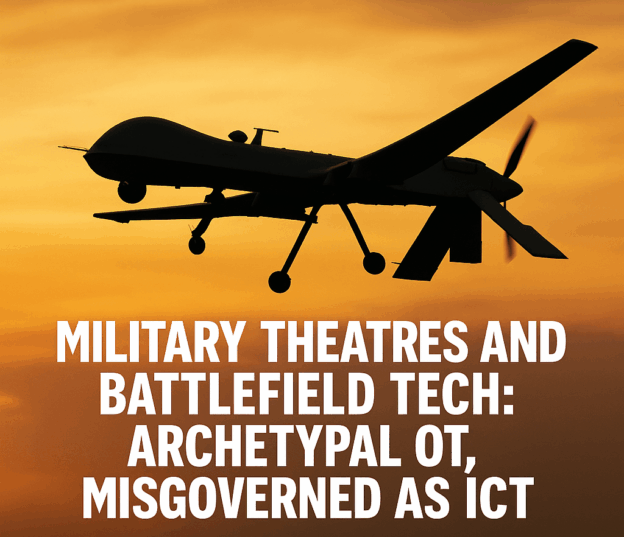This article examines how military theatres, battlefield systems, and drone technologies are quintessential Operational Technology (OT) environments, yet are often mismanaged under traditional ICT frameworks. It highlights the real-time, cyber-physical, and life-critical nature of defence systems, and argues for a shift toward mission-aware OT security governance to prevent strategic and kinetic failures.
Contents
Introduction
Modern military environments are among the most complex operational systems on Earth. They are, by design, cyber-physical, latency-sensitive, safety-critical, and unforgiving of downtime. Yet, paradoxically, much of the cybersecurity tooling, doctrine, and governance applied to these environments remains derived from enterprise IT and office-based information assurance models.
This is not only outdated, it is dangerous.
How Military Theatres Exemplify OT Environments
| Feature | Operational Technology (OT) Relevance |
|---|---|
| Mission-critical uptime | Failure = loss of life or mission. No room for patching windows or downtime. |
| Embedded and bespoke hardware | Deployed systems often use ruggedised, custom hardware with long life cycles. |
| Air-gapped and semi-connected networks | Tactical systems operate with limited or intermittent connectivity, demanding autonomy. |
| Sensor-actuator loops | From target acquisition to drone strike, decisions are cyber-physical. |
| Safety and kinetic risk | A cyber compromise could result in actual kinetic damage. |
| Decentralised control | Units may operate independently, across varied and hostile terrains. |
Examples Within Defence OT
- Drones and Unmanned Systems: Combine real-time telemetry, command-and-control links, onboard decision systems, and kinetic payloads, this is OT in the extreme.
- Targeting Systems and Fire Control: Must operate with determinism and fail-safes; subject to strict timing and accuracy constraints.
- Forward Operating Base (FOB) Infrastructure: Power, water, perimeter control, and comms all rely on networked OT systems.
- Military Vehicles (Land/Sea/Air): Increasingly “platform-as-a-system”, vehicles are mobile OT nodes, not just transport.
- Logistics and Supply Chains: Autonomous routing, battlefield refuelling, and depot management all involve OT networks.
Why the Misclassification Persists
- Security clearances and bureaucracy: Security is handled by protocol and compliance, not by design.
- Cultural lag: The separation between “cyber” and “combat” is deeply ingrained, despite their operational convergence.
- Contractor ecosystems: Defence contractors often deliver integrated OT systems, but the cyber governance is handed off to internal IT.
OT-Likeness Score
| Environment | OT-Likeness | Notes |
|---|---|---|
| Drone and Autonomous Systems | 10 | Real-time, cyber-physical, embedded systems, low tolerance for delay |
| Fire Control and Targeting | 10 | Safety-critical, deterministic behaviour |
| Military Vehicles | 9 | Highly integrated platforms with real-world impact |
| FOB Infrastructure | 8 | Multi-system dependency, often air-gapped |
| Cyber Warfare Operations | 6 | Blurs lines—tactical cyber ops might not be OT, but they affect OT targets |
Conclusion: The Battlefield Is an OT Domain
The battlefield has always been an operational domain. Now, it is an Operational Technology domain, too. The tools of modern warfare, from drone fleets to targeting systems, are as much digital control systems as they are weapons. To treat them as enterprise IT endpoints is not just incorrect, it is a critical failure of doctrine.
Security in the military context must evolve from policy-led ICT compliance to mission-aware OT security engineering. Anything less is a risk to sovereignty, personnel, and lives.
